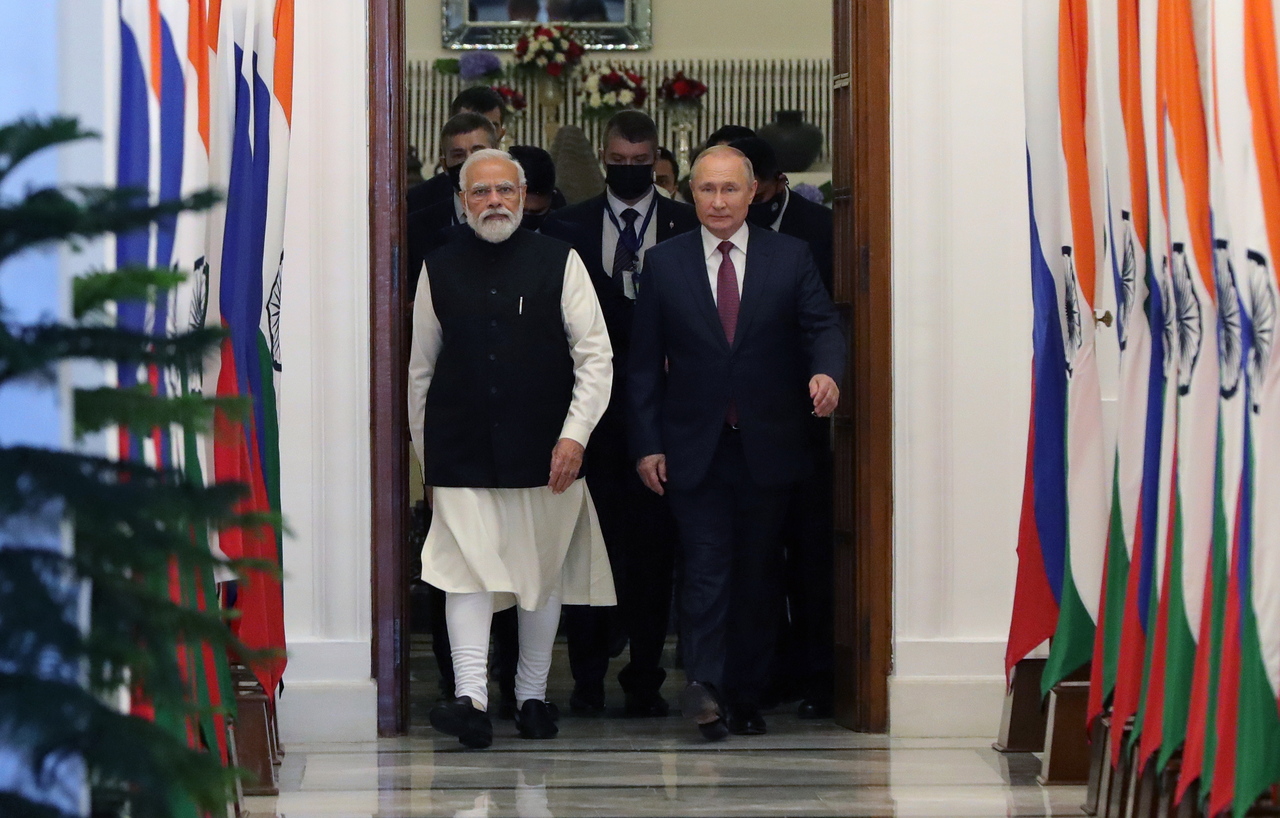The Asian Voice
India-Russia ties in a changing world: Daily Star columnist
The writer says India-Russia engagement at the summit level has been sustained despite the changing international landscape.
Sign up now: Get ST's newsletters delivered to your inbox

Indian Prime Minister Narendra Modi (left) with Russian President Vladimir Putin during their meeting in New Delh on Dec 6, 2021.
PHOTO: EPA-EFE/SPUTNIK POOL
Pallab Bhattacharya
Follow topic:
DHAKA (THE DAILY STAR/ASIA NEWS NETWORK) - As Russian President Vladimir Putin wrapped up his six-hour visit to New Delhi on Dec 6, most commentaries on India-Russia relations invariably termed it as the continuation of decades of romance that first blossomed in the Cold War era-a global geo-political scenario that is very different from what it is today.
Few have noted the important coincidence that Putin's visit took place on the day India and Bangladesh celebrated "Maitri Divas" at a function held in New Delhi, addressed by Prime Minister Sheikh Hasina, albeit through a recorded video message.
After all, it is the Liberation War of 1971, which led to the emergence of Bangladesh as an independent nation, that added a new depth in strategic ties between India and the then Soviet Union.
During that time, the warming of ties between the US and China under the stewardship of Richard Nixon and Henry Kissinger, Pakistan's Operation Searchlight in then East Pakistan, and the grave security challenge posed by the Washington-Beijing tie-up pushed India and the Soviet Union to sign the landmark 1971 Treaty of Peace, Friendship and Cooperation, which envisaged each other's help in defending their territorial integrity.
The international scenario has, of course, changed since 1971. But one thing that has remained constant between then and now is the flux in that scenario. No wonder that India's ruling establishment, irrespective of their ideological moorings, has not given up any opportunity to gush about how India-Russia ties have been tested through vicissitudes and changing times. The Cold War is long gone.
Today, India has moved much closer to the US, and Russia and China have grown closer in the face of Russia's frayed relations with the US and Europe. But what has not changed is the sustained India-Russia engagement at the summit level-the meeting between Putin and Modi in Delhi on Dec 6 was the 21st top-level interaction, possibly unprecedented for any two countries.
Three major takeaways from the Putin-Modi summit are in defence and trade. The two countries entered into a 10 year pact on military-technical cooperation, which includes a deal for manufacturing AK203 assault rifles in a factory in India's Uttar Pradesh state. Contrary to expectations, however, the two countries failed to ink an agreement on logistical support for each other's military because, as Indian Foreign Secretary Harsh Vardhan Shringla said, there were a "few issues" that remain to be sorted out. India already has such military logistics support agreements with a number of countries, including the US.
To take defence and diplomatic ties forward, India and Russia have for the first time institutionalised meetings between their defence and foreign ministers, who held their first in-person and delegation-level talks under that format. India and the US already have the same institutional arrangement.
On trade, the two sides acknowledged that this front has been somewhat lagging, as the volume of bilateral trade is not commensurate with the depth of the strategic partnership between India and Russia. They set a target of trebling the volume of trade in goods from US$10 billion (S$13.63 billion) at present to US$30 billion in the next four years, a tall order by any yardstick. The two countries looked to new areas for long-term cooperation to achieve this.
By contrast, India's trade with the US and China are close to US$100 billion, and Russia's trade with China is pegged at slightly over the same amount. But a robust trade is no guarantee for a burgeoning relationship in other areas. High stakes in trade do not always dampen political and military tensions-India-China, US-China and Japan-China are examples of that.
It is a sign of maturity on the parts of India and Russia that they have not allowed the ties between New Delhi and Washington, and Beijing and Moscow, to come in the way of boosting and diversifying their own bilateral relations.
For instance, India has gone ahead with procuring the S-400 Triumf air missile defence system from Russia despite the threats of sanctions from the US. Secondly, Indian Defence Minister Rajnath Singh, during the bilateral meeting with his Russian counterpart Sergei Shoigu on Dec 6, raised upfront the issue of China's combativeness on the unresolved border along the Himalayas. True, Rajnath did not name any names, but his reference to the military tensions in India's northern border with China left little doubt as to whom he had in mind.
More importantly, Rajnath used this tension to seek greater military cooperation with Russia considering the "real, immediate and legitimate defence challenges" posed by China, and expressed the hope that Moscow will remain a major partner for New Delhi in these "changing circumstances."
India and Russia are also not entirely on the same page as far as the security scenario in Asia-Pacific-which China considers to be its backyard-is concerned. As both India and Russia seek new allies, the flames of their long-standing ties continue to burn brighter.
- Pallab Bhattacharya is a special correspondent for The Daily Star. The Daily Star is a member of The Straits Times media partner Asia News Network, an alliance of 23 news media organisations.

